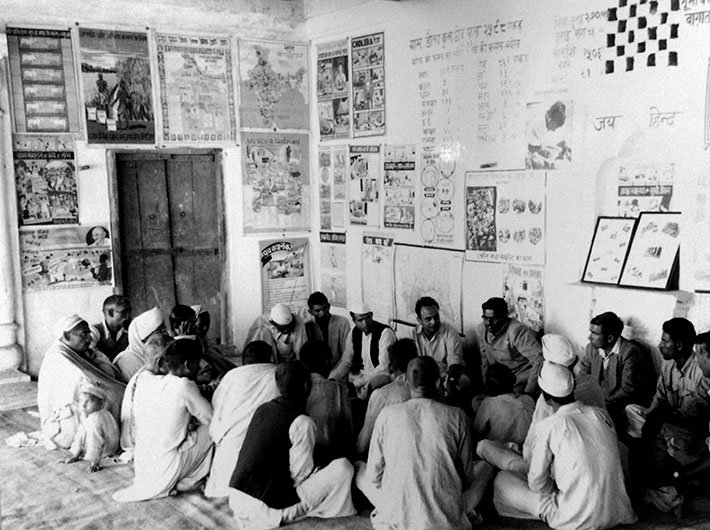While some states are enthusiastic, others are reluctant to go ahead. However, the government of India is betting big on the transformative change e-Panchayat promises to bring to villages
When the government began rolling out the e-Panchayat project, it was widely expected to change the governance structure at the village level all across the country. But like all things in India, some states have taken to it wholeheartedly, others are reluctant participants and several are just not there in the picture. The project’s most ambitious goal is to bring processes of decentralised planning, budgeting, accounting, implementation, monitoring and even issuance of certificates and licences on to a common digital platform.
It has, however, been five years since the ambitious plan was drafted, but the ministry of panchayati raj (MoPR) and the national informatics centre (NIC) have, at the cost of '50 crore, developed a set of web applications that cover only the core functions of the panchayat administrative process. The dream of a radical change in the village administrative structure throughout India remains only that, a dream. Interestingly, in the current five-year plan the project has been brought under the Rajiv Gandhi Panchayat Sashaktikaran Abhiyan (RGPSA) and has been allotted a massive '6,106 crore.
The objectives of the project seem clear enough on paper but on the ground the reality seems to be very different. Several people associated with panchayats are unaware of the project’s objectives and at best look at it as just another tool to capture and store data. Take Dholpur in the Rajasthan for instance. The moment one enters its villages, around 300 km from the capital Jaipur, it’s evident that e-Panchayat is yet to make its presence felt.
The common refrain of a gathering of about 50 panchayat secretaries was about the absolute lack of internet connectivity. One secretary said, “What e-Panchayat? We have to go to the block level office every 15 days to update the accounts.” In Dholpur only four of the 11 applications — PRIASoft, area profiler, national asset directory and local governance directory — are fully functional. Their reach is also restricted to the block level due to lack of connectivity. This has resulted in the four operating in a completely offline format at the gram panchayat level. “Right now there is internet connectivity till the district level. However, due to slow internet connectivity data uploading gets delayed by up to eight days,” said Ravi Kumar, who is part of the district programme management unit (DPMU).
State government officials, however, say that each gram panchayat has been given an internet data card under the RGSPA to address the connectivity issue. The gram panchayat secretaries, however, hotly contest this claim. “That is not true. There is no uniform network that works across all villages. How will they give us data cards?” questions Ramesh Chandra, panchayat secretary of the Raja Kheda gram panchayat.
Power and connectivity, the basic requirements for any computerised system, have proved to be major roadblocks in the implementation of e-Panchayat in Rajasthan, and in several other states. “It is the responsibility of the states to take care of these issues so that things can fall in place,” said an NIC official associated with the project. “Despite our best efforts we have not been able to institutionalise e-Panchayat in states. To institutionalise it across the country will be impossible.”
More than just a data-entry tool
Many view e-Panchayat as just a platform for the panchayats to upload and store their information. But the ministry and the policy mandarins see it as an empowering tool that will help in policy formulation, structuring of welfare schemes and better administration of panchayats.
According to the block development officer (BDO) of the Srinagar block, Ajmer, ML Sharma, “The state departments have started compiling data from the e-Panchayat software. This information can be used for policy making at a future level. For example states can use the area profiler to make specific schemes for specific areas.”
The most popular application is the PRIASoft, which is the accounting software for the panchayat inflows, outflows and budgeting. “The application has definitely increased the level of transparency. It is a means of keeping a check on both sides. At the state level, the officer knows he has to update the accounts, so he is very careful with the amount he sanctions,” added Sharma.“The sarpanch is also updated with his accounts. Earlier he would lose the cash book, or even force the panchayat secretary to draw up checks of exaggerated amounts.”
States like Maharashtra, Chhattisgarh, Kerala and Karnataka where e-governance has had a strong foothold, the mission mode projects related to panchayats and rural development, especially e-Panchayat, have moved ahead in rapid strides. In Kerala, for example, 25 percent of its budget is earmarked for the continuous development of the panchayats.
In Chhattisgarh the project has reached its second phase. Explaining why the state is considered one of the top performing states, AM Parial, vice-chairman, Chhattisgarh infotech and biotech promotion society (CHiPS), said, “The basic data creation has been completed. Innovative ways of data collection has begun in a big way. Now the second layer (service delivery) of the project has started trickling in,” he said.
“When the e-PRI project was conceptualised the key assumption was to put a basic infrastructure in place. Unfortunately that is taking time. In the coming years when connectivity reaches every corner of the state we will see true transformative change,” Parial explained.
In Karnataka, the local NIC has created a set of applications that are state specific and running successfully, giving the project a certain level of achievement. Giving update of the project in the state, Karnataka rural development and panchayati raj secretary Gangaram Baderiya said, “Panchatantra, Worksoft and e-Swatthu applications are in line with PlanPlus and Action Soft of e-Panchayat. They have been implemented in Karnataka in all zilla and gram panchayats.”
West Bengal, another top performer, is one of the four states that already have its own accounting software in place. Speaking about the success of the project in the state, Jayant Chatterjee, area project officer (IT), department of panchayats and rural development, government of West Bengal, said, “We have our own accounting software — gram panchayat management system (GPMS) — since 2005. The panchayats are delivering important services like life and death certificates. However, connectivity is still a hurdle. Out of all the gram panchayats, probably one-fifth have very good connectivity. As of now, in the first phase, the state has implemented six applications. The second phase, which will be rolled out soon, we will cover the training aspect of the project.”
Along with Maharashtra, West Bengal is one of the states to introduce e-tendering at the panchayat level. “For transactions of a high value, those with digital signatures have the authority to sanction it. On an average, we get about five requests a day for digital signatures. This trend has picked up only in the last one year,” said Chatterjee.
Considered a leader in implementation of e-PRI, Maharashtra has gone a step ahead and introduced the concept of financial inclusion through the panchayat centres. According to Rajesh Aggarwal, IT secretary, Maharashtra, “With the e-PRI project we can deliver certificates through the sarpanchs and the gram sevaks. We do not have to go to the block level.”
He further said that the e-PRI centres have started acting as business correspondents. “They have the facility to open accounts. The state has also introduced e-tendering process for any panchayati transactions that is above '5,00,000,” he said.
Keeping these success stories in mind Sharma pointed out: “The project will be successful in all states only if it is implemented simultaneously and in one go. Implementing it in a phased manner divides authority and the responsibility. The project has been successful in Kerala because the state has full faith in the panchayats. It gave panchayats all the resources.”

